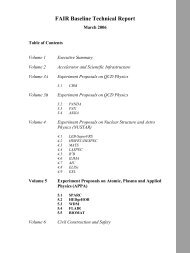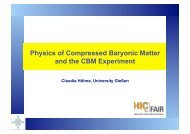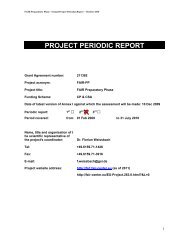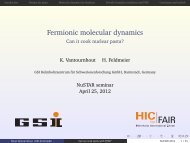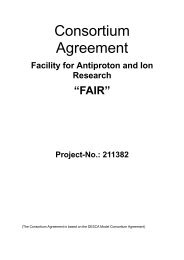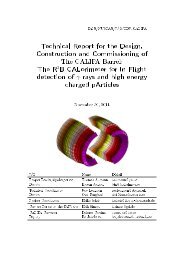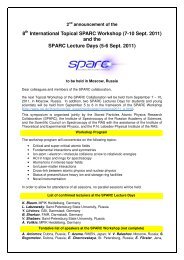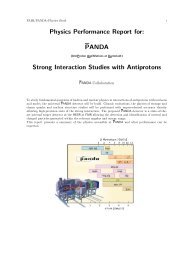NeuLAND - FAIR
NeuLAND - FAIR
NeuLAND - FAIR
You also want an ePaper? Increase the reach of your titles
YUMPU automatically turns print PDFs into web optimized ePapers that Google loves.
B.7. MRPC Solution using Glass as Converter<br />
As an alternative, a new concept for the detection of high energy neutrons based on<br />
RPC’s was also proposed. This concept considers only glass as converter material.<br />
There is no iron in the whole detector.<br />
Based on a modular geometry, each RPC module contains a certain number of glass<br />
electrodes separated by 300 µm, operated in a standard gas mixture. The gas gaps are<br />
encapsulated in a gas tight plastic box, which only contains feed-throughs for the active<br />
gas (a standard mixture of 90% freon and 10% SF6) and the high voltage. The readout<br />
strips are allocated outside the plastic box. The whole system is electrically isolated by<br />
a metallic shielding. Based on simulation studies using the R 3 BROOT framework, the<br />
thickness of the glass plates has been chosen to be 3 mm [Mac-11]. A schematic view<br />
of the iron-less RPC concept is shown in the left panel of figure B.11. A RPC module<br />
(100 cm × 50 cm) based on the iron-less RPC concept already exists at LIP-Coimbra,<br />
and it can be seen in the right panel of figure B.11.<br />
Metallic shielding<br />
Figure B.11.: Schematic drawing (left) and photograph (right) of the iron-less RPC module<br />
with the readout electrodes.<br />
A number of up to 8 modules with dimensions 200 × 50 cm is presently under construction<br />
at LIP-Coimbra. The performance of this new concept in the detection of high<br />
energy neutrons will be tested during the allocated deuteron break-up experiment at the<br />
R 3 B setup during 2012.<br />
B.8. Summary and Outlook<br />
The development of the MRPC option for <strong>NeuLAND</strong> provided many valuable insights.<br />
One of the largest area MRPC structures ever built was developed for the purpose, and<br />
it was unambiguosly shown that the structure will even work as an MRPC in its strongly<br />
modified form using thick passive converters.<br />
The first MRPC-based neutron detector we are aware of has been built, and it was<br />
shown that an MRPC-based detection concept can work for 1 GeV neutrons. Also, the<br />
Neutron MRPC development for <strong>NeuLAND</strong> was an important driver in the development<br />
112





